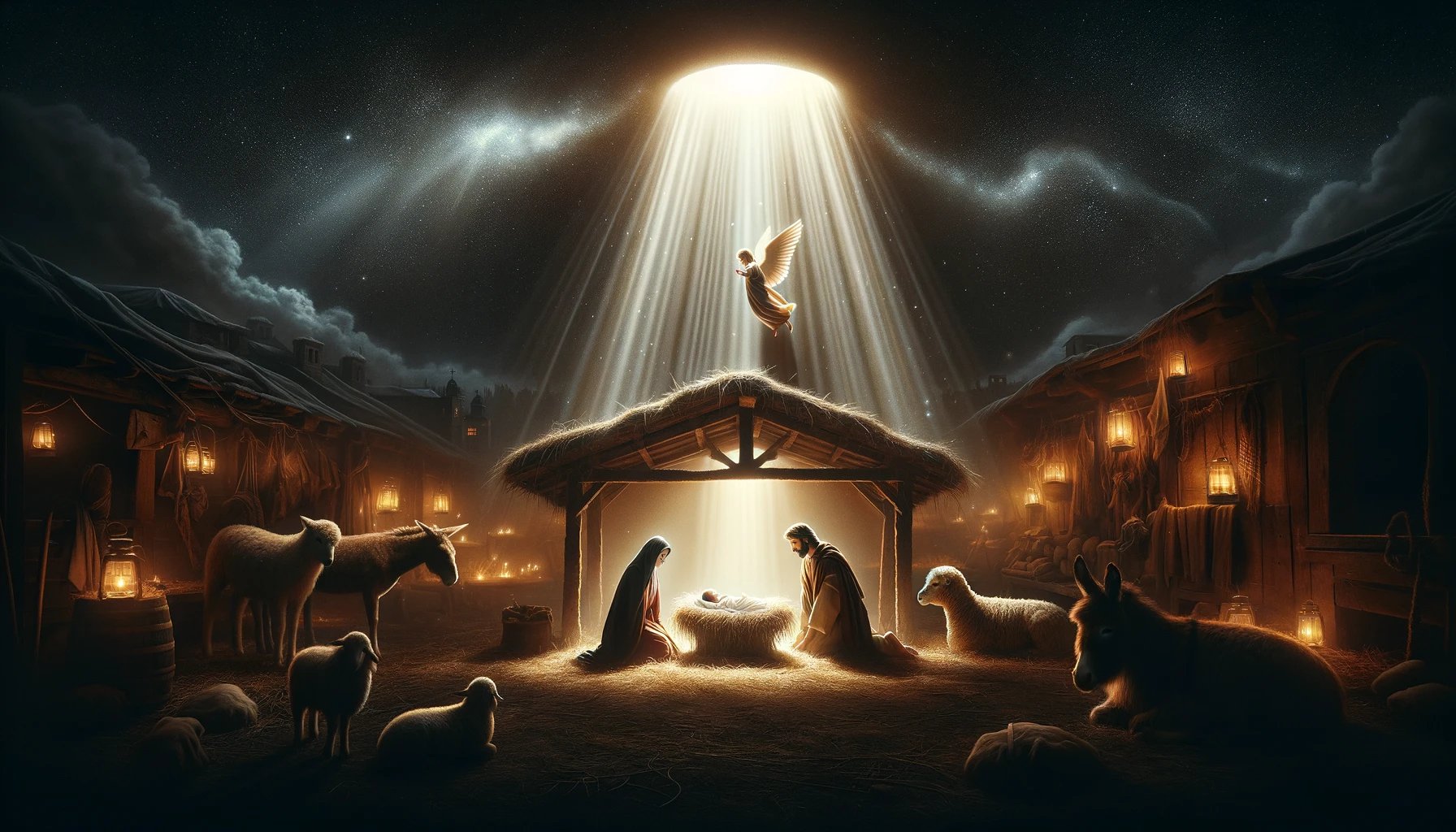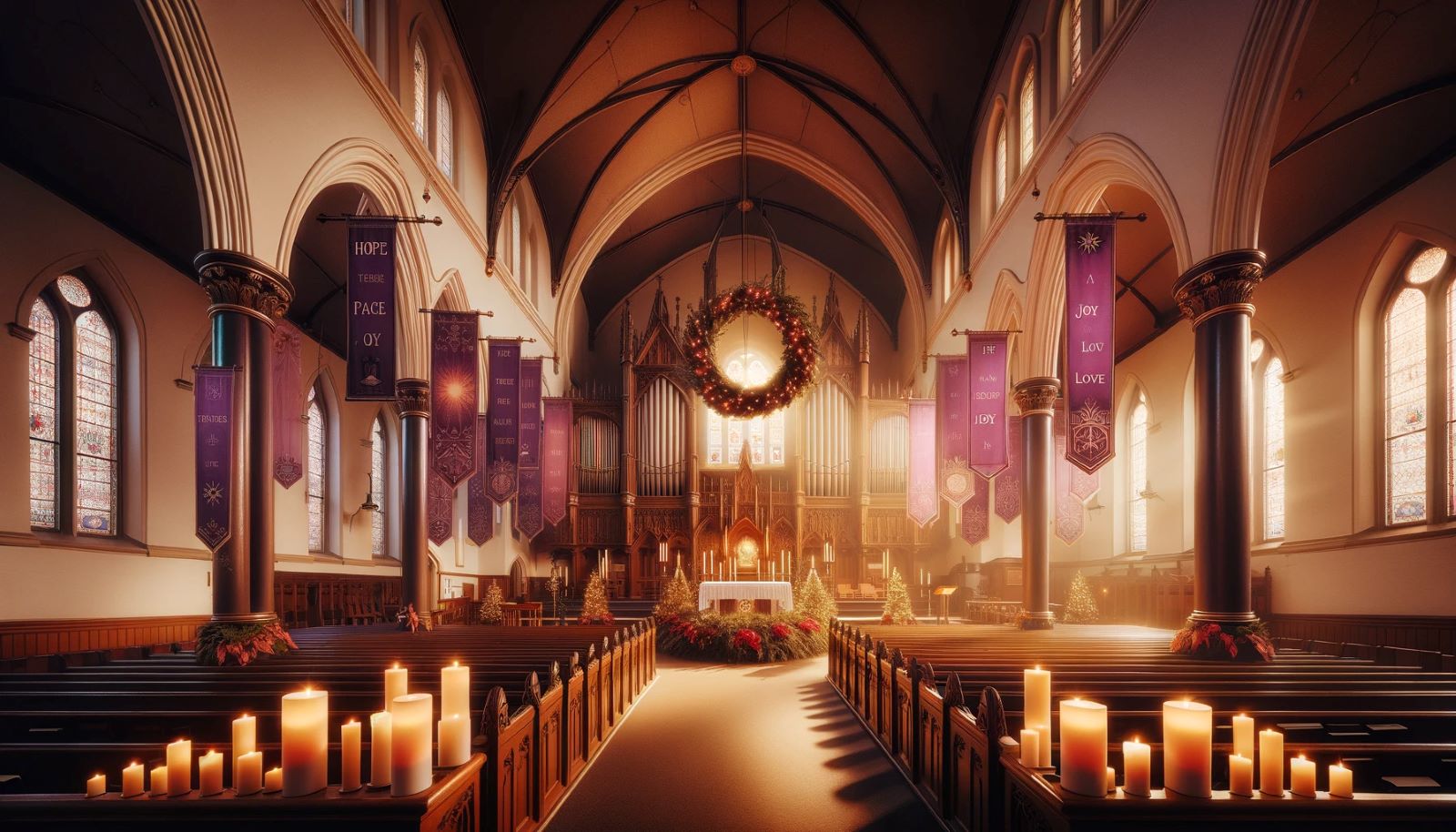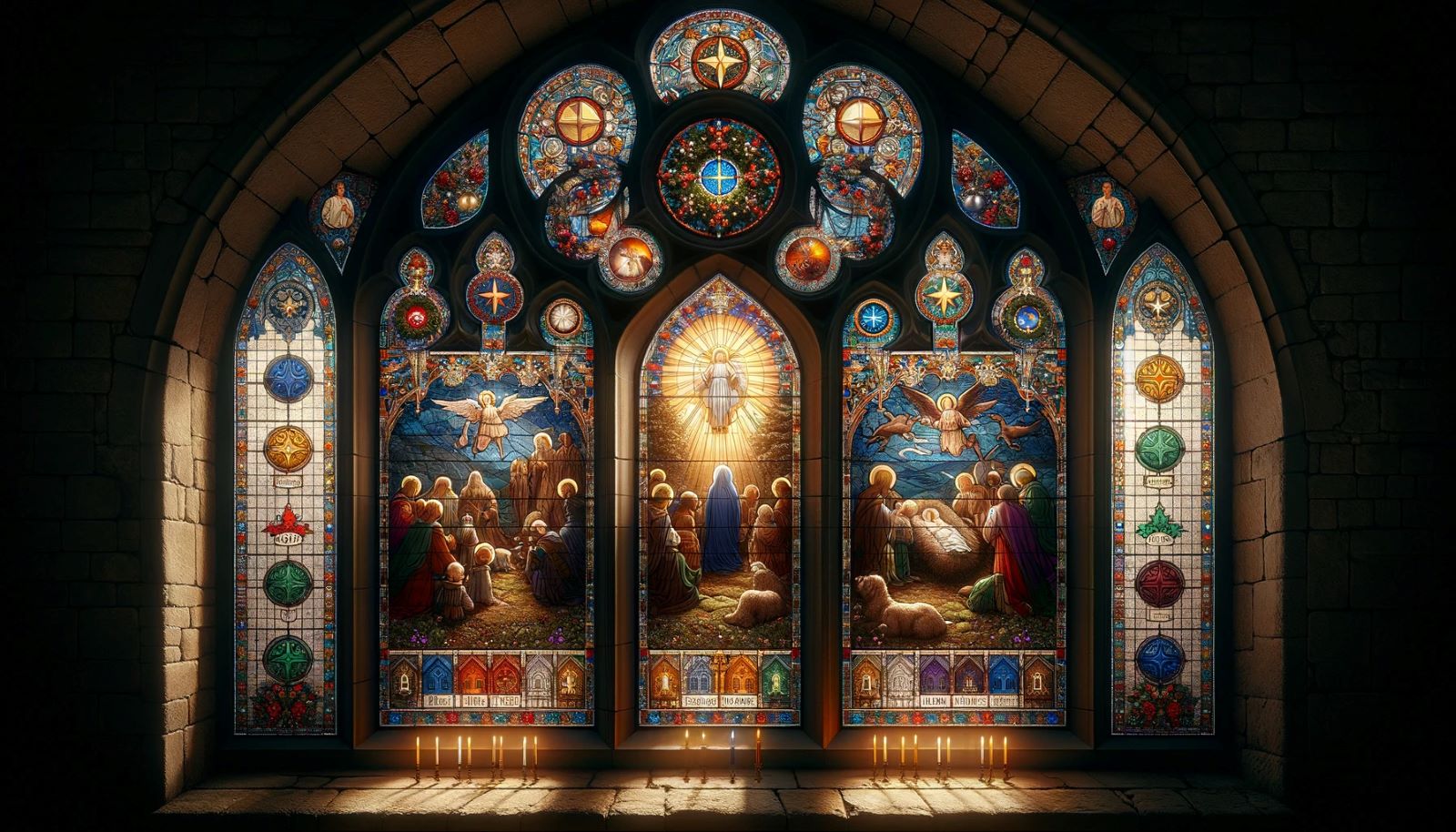Home>Special Themes>What Is The Color Of Advent


Special Themes
What Is The Color Of Advent
Published: February 13, 2024
Peter Smith, Editorial Director at Christian.net, combines deep insights into faith, politics, and culture to lead content creation that resonates widely. Awarded for his contributions to religious discourse, he previously headed a major organization for religious communicators, enhancing dialogue on faith's societal impacts.
Discover the significance and symbolism of the color of Advent in this insightful exploration of special themes. Uncover the spiritual meaning and traditions associated with this unique period of anticipation and preparation.
(Many of the links in this article redirect to a specific reviewed product. Your purchase of these products through affiliate links helps to generate commission for Christian.net, at no extra cost. Learn more)
Table of Contents
Introduction
Advent, a word derived from the Latin "adventus," meaning "coming," marks the beginning of the liturgical year in many Christian traditions. It is a time of spiritual preparation and anticipation for the celebration of the birth of Jesus Christ. The observance of Advent varies among different denominations, but it generally spans the four Sundays leading up to Christmas Day.
During this period, Christians reflect on the significance of the incarnation of Christ and eagerly await his second coming. Advent is a season of hope, joy, love, and peace, and it provides a meaningful opportunity for believers to deepen their faith and draw closer to God.
The colors associated with Advent play a significant role in setting the tone for this sacred time. Each color holds symbolic meaning and serves as a visual representation of the themes and emotions intertwined with the Advent season. Understanding the significance of these colors enriches the spiritual experience and fosters a deeper connection to the traditions and teachings of the faith.
In the following sections, we will delve into the rich history of Advent, explore the symbolism of its colors, and uncover the profound meanings behind the traditional hues of purple, pink, blue, and white. By gaining insight into the symbolism of these colors, we can appreciate the depth of the Advent season and the profound spiritual truths it embodies.
Read more: What Is Advent Conspiracy
The History of Advent
The history of Advent can be traced back to the early centuries of Christianity. While the specific origins of Advent as a liturgical season are not definitively documented, its roots can be found in the practices of early Christians who sought to prepare for the celebration of the birth of Jesus Christ.
In the early Church, the period leading up to Christmas was a time of fasting and penance, akin to the season of Lent preceding Easter. This preparatory period varied in length and intensity, with different regions and Christian communities observing it in diverse ways. Over time, the observance of Advent evolved, and its duration was standardized to encompass the four Sundays preceding Christmas.
The development of Advent as a distinct liturgical season can be attributed to the desire to create a dedicated time for spiritual reflection and anticipation of the coming of Christ. As the Christian calendar took shape, Advent became firmly established as a period of preparation, symbolizing the spiritual journey of the faithful as they awaited the birth of the Savior.
The themes of hope, anticipation, and longing for the Messiah are deeply woven into the fabric of Advent. The season serves as a reminder of the ancient prophecies foretelling the coming of a Redeemer and the fulfillment of God's promise to humanity. Through Scripture readings, prayers, and devotional practices, believers are invited to immerse themselves in the profound narrative of salvation history, embracing the anticipation of Christ's birth and the promise of his return.
Throughout the centuries, the observance of Advent has been shaped by various cultural and ecclesiastical influences, leading to a rich tapestry of traditions and customs. While the specific practices associated with Advent may vary among different Christian denominations, the overarching purpose remains constant: to prepare hearts and minds to receive the gift of God's love incarnate in the person of Jesus Christ.
As we delve into the symbolism of Advent colors and their significance, it is essential to recognize the historical foundation upon which this sacred season is built. The history of Advent serves as a testament to the enduring significance of preparing for the coming of Christ, both in remembrance of his birth and in anticipation of his glorious return.
The evolution of Advent as a season of spiritual preparation underscores the timeless relevance of its themes and the enduring impact of its traditions on the lives of believers around the world.
The Symbolism of Advent Colors
The colors associated with Advent hold profound symbolic significance, each representing a distinct aspect of the spiritual journey leading up to the celebration of Christ's birth. These hues serve as visual reminders of the overarching themes of hope, love, joy, and peace that permeate the Advent season. By understanding the symbolism behind these colors, believers can engage more deeply with the spiritual richness of this sacred time.
Purple
The color purple has long been synonymous with royalty and majesty. In the context of Advent, it symbolizes penitence, preparation, and anticipation. This rich hue invites believers to engage in introspection and repentance, acknowledging the need for spiritual readiness to receive the coming Messiah. It serves as a visual call to prepare the heart and mind, embracing a posture of humility and contrition as one awaits the fulfillment of God's promises.
Pink
The introduction of the color pink, often represented as rose in liturgical settings, marks a moment of joyful anticipation within the Advent journey. This gentle hue symbolizes the budding joy and anticipation of the imminent arrival of Christ. It serves as a beacon of hope, signaling the nearness of the long-awaited celebration of the Savior's birth. The pink candle, often lit on the third Sunday of Advent, known as Gaudete Sunday, radiates a message of rejoicing amidst the anticipation, reminding believers of the imminent fulfillment of God's redemptive plan.
Read more: What Is An Advent Church
Blue
In some Christian traditions, the color blue is used to symbolize hope and expectation during Advent. This serene hue evokes a sense of calm assurance and steadfast hope in the promises of God. It serves as a visual representation of the anticipation of Christ's coming, inspiring believers to fix their gaze on the hope found in the fulfillment of divine promises. The color blue invites contemplation on the profound assurance of God's faithfulness and the anticipation of the fulfillment of His redemptive plan for humanity.
White
White, often associated with purity and light, is utilized in Advent to symbolize the culmination of the season in the celebration of Christ's birth. This pristine hue represents the purity and holiness of the incarnate Son of God, whose birth brings light and salvation to the world. White serves as a visual proclamation of the joyous fulfillment of God's promise, illuminating the path to redemption and inviting believers to rejoice in the wondrous gift of Christ's presence among humanity.
The symbolism of Advent colors enriches the spiritual tapestry of the season, inviting believers to engage with profound truths and timeless promises. Each hue serves as a poignant reminder of the multifaceted journey of anticipation, repentance, joy, and ultimate fulfillment woven into the fabric of Advent, deepening the spiritual significance of this sacred season.
The Color of Advent: Purple
The color purple holds a significant and profound symbolism within the context of the Advent season. As the primary color associated with Advent, purple serves as a visual representation of penitence, preparation, and anticipation. Its rich and regal hue evokes a sense of solemnity and introspection, inviting believers to embark on a journey of spiritual readiness as they await the celebration of Christ's birth.
In the liturgical tradition, purple has long been associated with repentance and humility. It calls upon individuals to engage in self-reflection, acknowledging the need for inner preparation to receive the coming Messiah. The use of purple during Advent underscores the importance of cultivating a spirit of contrition and openness to God's transformative work within the heart. It serves as a visual call to embrace a posture of humility, recognizing the profound significance of preparing the innermost depths of the soul to receive the gift of God's love incarnate in the person of Jesus Christ.
Furthermore, the color purple carries historical connotations of royalty and majesty. In the context of Advent, this symbolism takes on a deeper spiritual significance. It reminds believers of the majestic nature of the One whose coming they eagerly anticipate – the promised Messiah, whose birth heralds the dawning of a new era of salvation and redemption. The regal undertones of purple serve as a poignant reminder of the exalted nature of the divine gift that awaits, prompting individuals to approach the Advent season with reverence and awe.
The use of purple in Advent decorations, liturgical vestments, and ceremonial elements serves as a visual anchor, grounding believers in the solemnity and significance of the season. It creates a sacred ambiance that fosters a spirit of contemplation and spiritual preparation, guiding individuals to embrace the call to repentance and readiness as they journey towards the celebration of Christ's birth.
In essence, the color purple in the context of Advent encapsulates the themes of penitence, preparation, and anticipation. Its rich symbolism invites believers to engage in a profound spiritual introspection, acknowledging the need for inner readiness to receive the coming Messiah. As the foundational hue of the Advent season, purple sets the tone for a transformative journey of the heart, guiding individuals to embrace the solemn beauty of spiritual preparation as they await the joyous celebration of the birth of Jesus Christ.
The Color of Advent: Pink
The introduction of the color pink, often represented as rose in liturgical settings, marks a moment of joyful anticipation within the Advent journey. This gentle hue symbolizes the budding joy and anticipation of the imminent arrival of Christ. It serves as a beacon of hope, signaling the nearness of the long-awaited celebration of the Savior's birth. The pink candle, often lit on the third Sunday of Advent, known as Gaudete Sunday, radiates a message of rejoicing amidst the anticipation, reminding believers of the imminent fulfillment of God's redemptive plan.
Pink, with its soft and radiant presence, stands in stark contrast to the solemnity of purple, infusing the Advent season with a sense of joyful expectation. As the days draw closer to the celebration of Christ's birth, the color pink serves as a visual reminder that the long-awaited promise of redemption is about to be fulfilled. It encapsulates the essence of Gaudete Sunday, inviting believers to rejoice in the nearness of the Savior's arrival and to embrace the burgeoning joy that accompanies the anticipation of the Messiah's birth.
The symbolism of pink in Advent extends beyond mere visual aesthetics; it embodies the profound truth that the arrival of Christ brings forth a transformative joy that transcends earthly circumstances. It serves as a testament to the enduring hope and uncontainable joy that emanate from the promise of salvation fulfilled in the person of Jesus Christ. The pink candle, when lit, radiates a warm and inviting glow, symbolizing the growing anticipation and the radiant joy that permeate the hearts of believers as they draw closer to the celebration of the Nativity.
Furthermore, the color pink serves as a poignant reminder of the faithfulness of God in fulfilling His promises. It heralds the approaching fulfillment of the ancient prophecies and the dawning of a new era of hope and redemption. The gentle yet vibrant hue of pink encapsulates the profound truth that the birth of Christ brings forth a joy that surpasses all understanding, infusing the Advent season with a sense of exuberant anticipation and uncontainable rejoicing.
In essence, the color pink in the context of Advent encapsulates the themes of joyful anticipation and the nearness of the Savior's birth. Its gentle radiance serves as a visual proclamation of the imminent fulfillment of God's redemptive plan, inviting believers to rejoice in the approaching celebration of the birth of Jesus Christ.
Read more: What Is Advent ELCA
The Color of Advent: Blue
In some Christian traditions, the color blue holds profound significance within the Advent season, symbolizing hope and expectation. Unlike the traditional use of purple and pink, the inclusion of blue as an Advent color offers a unique perspective on the themes of anticipation and the steadfast assurance of God's promises.
Blue, with its serene and calming presence, evokes a sense of tranquility and steadfast hope. It serves as a visual representation of the unwavering assurance found in the promises of God, inviting believers to fix their gaze on the hope encapsulated in the imminent arrival of Christ. The color blue, often associated with the expanse of the sky and the depths of the sea, conveys a sense of boundless hope and the enduring nature of God's faithfulness.
Amidst the busyness of the Advent season, the color blue offers a respite, encouraging individuals to pause and reflect on the profound assurance of God's redemptive plan. It serves as a visual reminder that, amidst the complexities of life, the hope found in Christ remains constant and unchanging. The use of blue in Advent decorations and liturgical elements creates a sacred space for contemplation, fostering a spirit of quiet anticipation and unwavering trust in the promises of God.
Furthermore, the color blue serves as a testament to the enduring nature of hope amidst the challenges and uncertainties of the world. It embodies the profound truth that, in the midst of darkness, the light of Christ shines brightly, illuminating the path of faith and guiding believers towards the fulfillment of divine promises. The serene hue of blue encapsulates the essence of Advent as a season of expectant waiting, inviting individuals to anchor their hearts in the unshakeable hope found in the imminent arrival of the Savior.
In essence, the color blue in the context of Advent encapsulates the themes of steadfast hope and unwavering expectation. Its tranquil presence serves as a visual proclamation of the enduring assurance found in the promises of God, guiding believers to fix their gaze on the hope and anticipation woven into the fabric of the Advent season.
The Color of Advent: White
The color white holds profound symbolism within the context of the Advent season, representing the culmination of the season in the celebration of Christ's birth. Often associated with purity, light, and holiness, white serves as a visual proclamation of the joyous fulfillment of God's promise, illuminating the path to redemption and inviting believers to rejoice in the wondrous gift of Christ's presence among humanity.
In the liturgical tradition, the color white is utilized to mark significant celebrations, including the feast of Christmas. Its pristine hue embodies the purity and holiness of the incarnate Son of God, whose birth brings light and salvation to the world. White serves as a visual reminder of the transformative power of Christ's arrival, symbolizing the dawn of a new era of grace and redemption.
The use of white in Advent decorations, liturgical vestments, and ceremonial elements creates an atmosphere of radiant joy and exultant celebration. It serves as a visual beacon, guiding believers towards the culmination of the Advent journey and the joyous commemoration of the Nativity. The color white infuses the season with a sense of awe and wonder, inviting individuals to behold the profound mystery of the Incarnation and to rejoice in the boundless love revealed through the birth of Jesus Christ.
Furthermore, white serves as a testament to the enduring significance of Christ's birth as the fulfillment of ancient prophecies and the embodiment of God's redemptive plan. Its luminous presence encapsulates the profound truth that, in the birth of Christ, humanity encounters the purest expression of divine love and mercy. The color white radiates a message of hope and salvation, inviting believers to rejoice in the transformative power of Christ's presence among us.
In essence, the color white in the context of Advent encapsulates the themes of purity, joy, and the fulfillment of God's promise. Its radiant symbolism serves as a visual proclamation of the joyous culmination of the Advent season, guiding believers to rejoice in the wondrous gift of Christ's birth and to embrace the transformative grace emanating from the presence of the Incarnate Son of God.
Conclusion
In conclusion, the colors of Advent serve as vibrant threads woven into the tapestry of this sacred season, each hue carrying profound symbolism and evoking a range of emotions and spiritual truths. From the regal solemnity of purple to the gentle radiance of pink, the tranquil assurance of blue, and the radiant joy of white, the colors of Advent encapsulate the multifaceted journey of anticipation, repentance, joy, and ultimate fulfillment.
As believers embark on the Advent journey, the symbolism of these colors invites them to engage in a transformative spiritual experience. The rich history and symbolism of Advent, rooted in the anticipation of Christ's birth and the promise of his return, are brought to life through the visual language of these hues. The color purple calls for introspection and repentance, preparing hearts to receive the coming Messiah. Pink heralds the budding joy and anticipation of Christ's imminent arrival, infusing the season with a sense of exuberant hope. Blue offers a tranquil refuge, anchoring believers in unwavering hope and steadfast expectation. White culminates the season in a radiant celebration, proclaiming the joyous fulfillment of God's promise in the birth of Christ.
The significance of these colors extends beyond mere visual aesthetics; it embodies the profound truths and timeless promises of the Advent season. Each hue serves as a poignant reminder of the enduring hope, joy, love, and peace that permeate the Advent journey, inviting believers to immerse themselves in the profound narrative of salvation history and draw closer to the heart of God.
As we reflect on the symbolism of Advent colors, we are reminded of the timeless relevance of this sacred season. The colors serve as visual anchors, grounding believers in the rich traditions and spiritual truths that define the Advent journey. They invite individuals to embrace a posture of humility, joy, and unwavering hope as they await the celebration of Christ's birth.
In essence, the colors of Advent enrich the spiritual tapestry of the season, inviting believers to engage with profound truths and timeless promises. As we journey through the Advent season, may the symbolism of these colors inspire us to embrace the transformative grace and profound joy found in the birth of Jesus Christ, and may the vibrant hues of purple, pink, blue, and white serve as constant reminders of the enduring hope and promise encapsulated in the Advent season.













